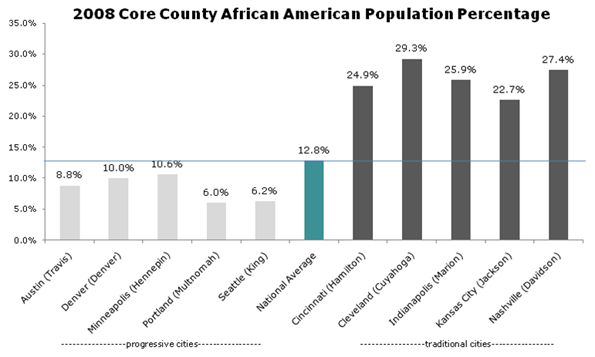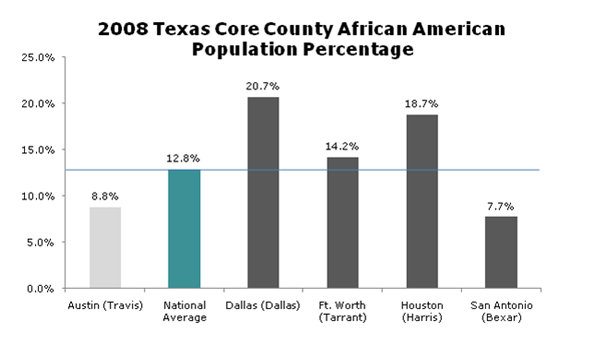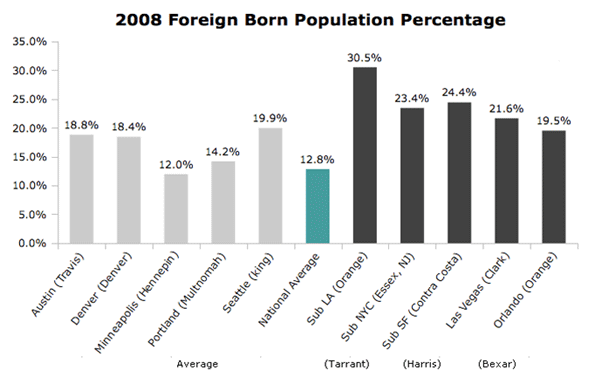
Among the media, academia and within planning circles, there’s a generally standing answer to the question of what cities are the best, the most progressive and best role models for small and mid-sized cities. The standard list includes Portland, Seattle, Austin, Minneapolis, and Denver. In particular, Portland is held up as a paradigm, with its urban growth boundary, extensive transit system, excellent cycling culture, and a pro-density policy. These cities are frequently contrasted with those of the Rust Belt and South, which are found wanting, often even by locals, as “cool” urban places.
But look closely at these exemplars and a curious fact emerges. If you take away the dominant Tier One cities like New York, Chicago and Los Angeles you will find that the “progressive” cities aren’t red or blue, but another color entirely: white.
In fact, not one of these “progressive” cities even reaches the national average for African American percentage population in its core county. Perhaps not progressiveness but whiteness is the defining characteristic of the group.

The progressive paragon of Portland is the whitest on the list, with an African American population less than half the national average. It is America's ultimate White City. The contrast with other, supposedly less advanced cities is stark.
It is not just a regional thing, either. Even look just within the state of Texas, where Austin is held up as a bastion of right thinking urbanism next to sprawlvilles like Dallas-Ft. Worth and Houston.

Again, we see that Austin is far whiter than either Dallas-Ft. Worth or Houston.
This raises troubling questions about these cities. Why is it that progressivism in smaller metros is so often associated with low numbers of African Americans? Can you have a progressive city properly so-called with only a disproportionate handful of African Americans in it? In addition, why has no one called these cities on it?
As the college educated flock to these progressive El Dorados, many factors are cited as reasons: transit systems, density, bike lanes, walkable communities, robust art and cultural scenes. But another way to look at it is simply as White Flight writ large. Why move to the suburbs of your stodgy Midwest city to escape African Americans and get criticized for it when you can move to Portland and actually be praised as progressive, urban and hip? Many of the policies of Portland are not that dissimilar from those of upscale suburbs in their effects. Urban growth boundaries and other mechanisms raise land prices and render housing less affordable exactly the same as large lot zoning and building codes that mandate brick and other expensive materials do. They both contribute to reducing housing affordability for historically disadvantaged communities. Just like the most exclusive suburbs.
This lack of racial diversity helps explain why urban boosters focus increasingly on international immigration as a diversity measure. Minneapolis, Portland and Austin do have more foreign born than African Americans, and do better than Rust Belt cities on that metric, but that's a low hurdle to jump. They lack the diversity of a Miami, Houston, Los Angeles or a host of other unheralded towns from the Texas border to Las Vegas and Orlando. They even have far fewer foreign born residents than many suburban counties of America's major cities.

The relative lack of diversity in places like Portland raises some tough questions the perennially PC urban boosters might not want to answer. For example, how can a city define itself as diverse or progressive while lacking in African Americans, the traditional sine qua non of diversity, and often in immigrants as well?
Imagine a large corporation with a workforce whose African American percentage far lagged its industry peers, sans any apparent concern, and without a credible action plan to remediate it. Would such a corporation be viewed as a progressive firm and employer? The answer is obvious. Yet the same situation in major cities yields a different answer. Curious.
In fact, lack of ethnic diversity may have much to do with what allows these places to be “progressive”. It's easy to have Scandinavian policies if you have Scandinavian demographics. Minneapolis-St. Paul, of course, is notable in its Scandinavian heritage; Seattle and Portland received much of their initial migrants from the northern tier of America, which has always been heavily Germanic and Scandinavian.
In comparison to the great cities of the Rust Belt, the Northeast, California and Texas, these cities have relatively homogenous populations. Lack of diversity in culture makes it far easier to implement “progressive” policies that cater to populations with similar values; much the same can be seen in such celebrated urban model cultures in the Netherlands and Scandinavia. Their relative wealth also leads to a natural adoption of the default strategy of the upscale suburb: the nicest stuff for the people with the most money. It is much more difficult when you have more racially and economically diverse populations with different needs, interests, and desires to reconcile.
In contrast, the starker part of racial history in America has been one of the defining elements of the history of the cities of the Northeast, Midwest, and South. Slavery and Jim Crow led to the Great Migration to the industrial North, which broke the old ethnic machine urban consensus there. Civil rights struggles, fair housing, affirmative action, school integration and busing, riots, red lining, block busting, public housing, the emergence of black political leaders – especially mayors – prompted white flight and the associated disinvestment, leading to the decline of urban schools and neighborhoods.
There's a long, depressing history here.
In Texas, California, and south Florida a somewhat similar, if less stark, pattern has occurred with largely Latino immigration. This can be seen in the evolution of Miami, Los Angeles, and increasingly Houston, San Antonio and Dallas. Just like African-Americans, Latino immigrants also are disproportionately poor and often have different site priorities and sensibilities than upscale whites.
This may explain why most of the smaller cities of the Midwest and South have not proven amenable to replicating the policies of Portland. Most Midwest advocates of, for example, rail transit, have tried to simply transplant the Portland solution to their city without thinking about the local context in terms of system goals and design, and how to sell it. Civic leaders in city after city duly make their pilgrimage to Denver or Portland to check out shiny new transit systems, but the resulting videos of smiling yuppies and happy hipsters are not likely to impress anyone over at the local NAACP or in the barrios.
We are seeing this script played out in Cincinnati presently, where an odd coalition of African Americans and anti-tax Republicans has formed to try to stop a streetcar system. Streetcar advocates imported Portland's solution and arguments to Cincinnati without thinking hard enough to make the case for how it would benefit the whole community.
That's not to let these other cities off the hook. Most of them have let their urban cores decay. Almost without exception, they have done nothing to engage with their African American populations. If people really believe what they say about diversity being a source of strength, why not act like it? I believe that cities that start taking their African American and other minority communities seriously, seeing them as a pillar of civic growth, will reap big dividends and distinguish themselves in the marketplace.
This trail has been blazed not by the “progressive” paragons but by places like Atlanta, Dallas and Houston. Atlanta, long known as one of America's premier African American cities, has boomed to become the capital of the New South. It should come as no surprise that good for African Americans has meant good for whites too. Similarly, Houston took in tens of thousands of mostly poor and overwhelmingly African American refugees from Hurricane Katrina. Houston, a booming metro and emerging world city, rolled out the welcome mat for them – and for Latinos, Asians and other newcomers. They see these people as possessing talent worth having.
This history and resulting political dynamic could not be more different from what happened in Portland and its “progressive” brethren. These cities have never been black, and may never be predominately Latino. Perhaps they cannot be blamed for this but they certainly should not be self-congratulatory about it or feel superior about the urban policies a lack of diversity has enabled.
Aaron M. Renn is an independent writer on urban affairs based in the Midwest. His writings appear at The Urbanophile.













misleading article
I imagine there is a pretty straightfoward explanation: income, education, and race are all correlated. Instead of having race as the metric, we could substitute income levels and have a completely different conversation. I think the way the article is presented is horribly misleading and, frankly, irresponsible. It makes it a lot easier to be progressive when you don't have to worry about putting food on the table or keeping your kids safe, whatever your race.
Interesting reading (except for the statistical nit-pikcing)
I found Wescott's post ("And this is news?" or something like that) to be a remarkable addendum to Aaron's central observation, with which I concur. (I am knowledgeable about Seattle in particular, Portland somewhat similarly, Chicago as a native and Philadelphia as an urban college student. I'm now closer to Cincinnati, whose population dynamics I'm still trying to more fully grasp, but I suspect its deep minority poverty levels *may* have some historical roots in it being free land for slaves when the Ohio River separated free from slave areas. The less energetic among them didn't move on during the post WWII Great Migration northward is my working hypothesis.)
The lesson-in-a-nutshell to be learned from Aaron's piece is that demographics is key to an urban area's destiny and character. Portland is a prime example -- sheesh, its 'progressivism' is gonna be worse than I experienced (and fled) in 27 years in Seattle.
For those interested in learning more on demographic 'herding' behavior', see Thomas Schelling's "Micromotives and Macrobehavior" chapter 'Sorting and Mixing', especially the 'A Self-Forming Neighborhood Model' section. He presents a nice intuitive spatial model using coins.
Broad Brush
roamer
Thought provoking article and insightful comments. A few thoughts...
We should be careful about making broad sweeping assertions as in "progressives" do this and "conservatives" do that and then deploying those labels to explain behavior or even worse, motivation.
Yet, the article poses interesting questions - why is it that so called urban "progressives" are often highly concerned about amenities such as dog parks, coffee houses, hip restaurants and art house cinemas. How about fellow citizens, who may be different, by race, class, wealth, ethnicity or any of myriad classifications? Well, not so much. The simple, but complex answer is that, as a nation, as a world for that matter, we're all a part of the same hypocrisy (to paraphrase Michael Corleone of "The Godfather" film), progressives included. Contradictions and illogic abound, that's what makes us human.
I live near Boston, certainly by any measure a "progressive" city and in the bluest of the blue states to boot. It's a highly walkable city, with great public transportation. However, the once dilapidated downtown area is rapidly becoming a series of gated communities rising into the sky. Just as sheltered, just as isolated as the much decried suburban McMansion communities. Now here’s what’s interesting - these new city-dwellers are actually working to create a "Disneyland" version of urban living!
Artists are being forced out of their lofts to make way for luxury condominiums, under the heading of "adaptive reuse," reuse which, ironically, has no use for the long-time residents. The marketing of the projects co-ops the artist cache, yet the local artists face extinction. Both the reusers and those that are used are almost exclusively white. The notion that race or ethnicity explains all urban dynamics just doesn't hold up to close scrutiny. In fact, the upscale progressives would likely be more welcoming and accepting of an Ivy League-educated black than a blue-collar worker from nearby South Boston. Upon closer inspection, you will find that some neighborhoods, which are celebrated for their diversity and progressiveness are actually quite segregated at the sub-neighborhood, block-by-block, house-by-house level. The most diverse section of the city is underground, in the subway system. Sit on the train, look around and you see America…
Wonder what explanations Malcolm Gladwell or the folks over at Freakomics would offer..?
Ugh
I know it's been a fad for awhile for white apologists to write articles in which they presume to know what black people want ("...not to be racist or anything") but if lack of appropriate minority percentages in a city is a "problem" that prevents it from being accurately touted as "progressive" - what is the solution? Do you think minorities (black folks in particular, to fit with the author) should be loaded into a cattle car and shipped to certain cities in order to beef up selective statistics? Did he do any research into the importance of family within the black community, or other priorities of minority populations that make living in the Pacific Northwest impractical - or is it just assumed that the only reason for a predominantly white population is because minorities have been unofficially banished?
Cities like Atlanta prove that predominantly black cities can be just as progressive, thriving, and economically booming as the so-called white cities mentioned in the article. As much as the author would like to further the opinion that minority communities need to be "saved," we're perfectly capable of saving ourselves.
What these "progressive" cities lack
Though the statistical analysis is a bit messy (it always is when comparing today's sprawling, multi-jurisdictional cities), I applaud the author's initiative in adressing the racial divide between cities seen as "progressive" and the older, post-industrial cities that are percieved as being behind the curve. I think the big issue here is the presence of large black populations who have been hit by the twin 20th century hardships of disappearing manufacturing jobs and persistent racism. This results in concentrations of poor blacks in large areas of these cities and becomes a drag on places trying to bring back middle and upper class people, mostly whites, who want to live in a safe and comfortable URBAN environment.
A couple thoughts:
1. The difficulty in growing and enhancing a city with a large and concentrated population of poor black people lies in both breaking the cycle of poverty and changing perceptions that in urban areas, race=class. Kids who grow up in areas of concentrated poverty face an enormous uphill climb and the odds are severely stacked against them. Sure, there are some who can overcome the odds, but let's not delude ourselves into thinking that urban poverty can be curtailed simply by people "pulling themselves up by their own bootstraps".
Secondly, we need to abandon the idea that racism is dead, and accept that there are still divisions within our society that need to be rectified. Seeing a bunch of black people on the street and saying aloud "this area is pretty ghetto" or "better roll up the windows" may not seem to be harming anyone, but it reinforces an invisible barrier between human beings and defines an entire race as both inferior and dangerous. As long as these ideas persist, upper class whites will largely avoid cities with large black populations.
2. There will always be poor areas, but the best option we have for advancing our cities is to break the cycle of poverty for younger generations. Investing heavily in schools and providing avenues for job training and paths to entry-level, middle class jobs is how this poverty can be alleviated, but it is neither cheap nor easy. We as a nation still have not reversed the damage that slavery, segregation, redlining, and racial hatred have had on our black populations. That is the legacy that burdens the so-called "non-progressive" cities. Just because the "progressive" cities do not have as big a problem with urban poverty does not mean that they are a model for the future. They simply have a cleaner slate to start with. As for the people who flock to Portland out of frustration with Cleveland, it is understandable, even justifiable to seek out a more comfortable place to live, but it is also selfish and anti-social to run away from problems rather than working to fix them. Perhaps we should have abandoned lower Manhattan after 9/11 or let New Orleans die after Katrina? What is needed is a national commitment to rebuild urban education and job training, so that we can finally reverse a problem that we as a society created in the first place.
intriguing
this article articulated ideas that i have been mulling over for a while , having grown up in austin and now living in seattle. what really bothers me about these cities is their relentless self-identification as progressive bastions when the kind of progressivism they offer actually seems to really lack any kind of racial justice lens. the dominant culture of these cities seems to me to basically be a white liberal one that at its best pays lip service to the issue of racism and never really ever challenges racism on economic, social, or cultural fronts. i dont think that the racism in these "progressive" cities is necessarily more insidious than it is in other cities of similar size, but it certainly feels more hypocritical. also, the actual lower population size of people of color in these cities makes it so that this dominant culture can kind of stifle any challenge to its self-image. that said, i have found in each of these places communities of color that actively assert their own progressive perspective and contest the white liberal one. cant say how these communities compare to similar ones in cities thought of as "less progressive" however. i have the feeling that they are not that different, that whether its a "liberal" city or not, they are fighting against the racism and economic and other inequalities that exist in our society everywhere.
A better title might be "The White County"
Using county demographics tends to understate the actual diversity of the cities in question. Thinking about diversity only in terms of black and white is also not very diverse, it seems to me. Seattle, for instance, is about 68 percent white, or 32 percent non-white. That doesn't mean that there is not a color-line in Seattle - south Seattle is predominantly non-white, while north Seattle is predominantly white (although increasingly Asian). There are convergence zones, however - Capitol Hill is the most diverse community in Seattle and also the most dense.
West coast cities also tend to have larger Asian populations and smaller black populations for largely historical reasons. Asian migration to the west coast dates back to the 19th century, while much of the black migration occurred beginning with WWII to work in wartime industries (ships, planes, etc). Black migration to the rust bucket began much earlier.
That said, transit-oriented development policies and urban growth boundaries can have the effect of driving minorities out of their traditional central urban neighborhoods, which are rapidly becoming gentrified (reverse white flight, I suppose). In Seattle, that increasingly means that the non-professional working class and the working poor, more likely to be non-white than not, is increasingly being driven to the urban fringe (Renton, Federal Way, White Center, etc.), where they have much poorer access to transit, social services, medical facilities, etc.
Atlanta has "Boomed"?
One issue the article failed to consider is the crime rate. Atlanta, residents endure three times the rate of violent crime that residents of the next largest city, Columbus, have to put up with. So how is this added into the mix that labels Atlanta some sort of New South Mecca? Ooops, I forgot, mentioning crime rates of cities with large minority populations is PC verboten. 'Scuuuse me!
Gee, I wonder if the ascendancy of these so-called "progressive" white cities has anything to do with values and behavior? Oooops! There I go again. Exit, staaaage right
white city
The cities mentioned as progressive white enclaves have one thing in common that makes them so attractive, and that is their embrace of the "creative class". They welcome different points of view and have a generally live and let live attitude. It's literally a more positive energy. It's not a diversity quota that you'd expect from the Post Office. If young educated people are moving to Austin or Portland, it's not because they don't want ethnic diversity, they are searching for creative diversity. By the way, that includes the exceptance of gays, who are a very distict minority group in their own right. I'm gay, and I live in Denver, and this city is very welcoming. By the way, Denver is only 50% white, and I DO like the ethnic diversity (large Latino population too). But to say that the black community is the "big kahuna" of diversity is not true. A black neighborhood is no more diverse than a white neighborhood. I wouldn't want to live in Salt Lake or Boise either, which are very white, but very conservative. Some of the progressive cities mentioned in the article simply have a more welcoming and forward-thinking personality.
White people heaven
Hey Aaron,
It seems you are getting quite a bit of flack about your stats...stats aside as a 'minority' resident of Austin for 6 years I can say that amongst my nearest and dearest I refer to places such as Austin as white people heaven. Portland and Seattle as well. Bus systems are for us poor minority folks while the high-falutin 'New Urbanist' ideas like walkable communities and transit are for white folks...or for us minority tokens that have made good, pulled ourselves up Horatio Alger style, got some education and some 'manners'- you know 'whitened up.' Be honest Austin, Portland, Seattle, etc. You know you don't have mass populations of poor minorities crowding you out in at your walkable coffee joint or teeming into your neighborhoods...or *gasp* attending school with your young, urbane, hipster children!